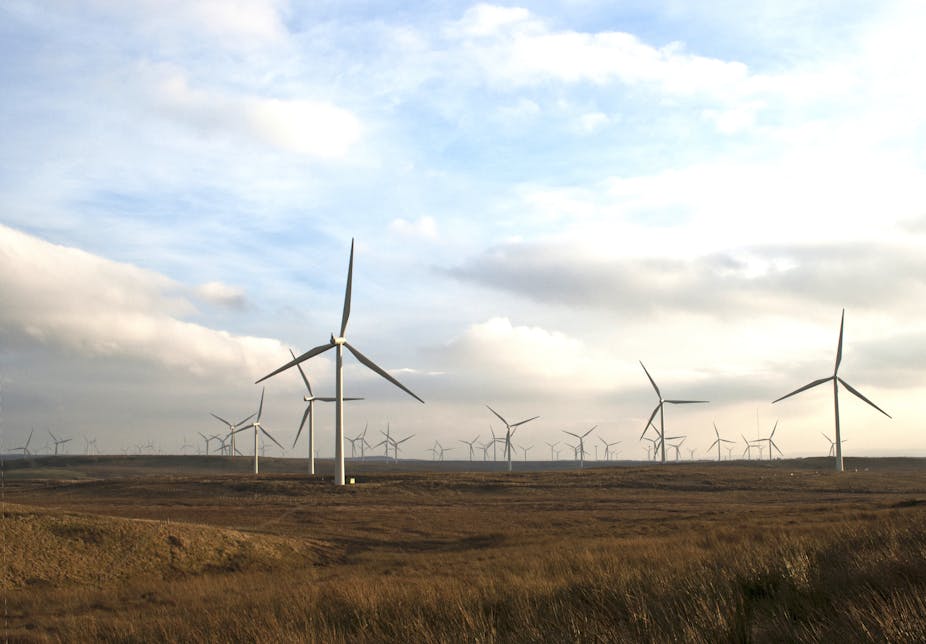Two years ago, the London School of Economics delivered bad news to the renewables industry. It published a research paper that showed that house price appreciation was significantly reduced by being near wind farms in England and Wales. This overturned previous work in both the US and UK which had found no robust evidence of a negative effect.
But what about Scotland? With emptier countryside and stronger winds, not to mention a more pro-renewables government, more than twice as much onshore wind power capacity has been built north of the border than in England. Until now, nobody had attempted a robust empirical study of the effect on Scottish house prices – despite some anecdotal claims of a negative impact.
We set out to discover whether there was evidence to support these claims, using similar methods to the LSE study. But our results suggest the impact is very different in Scotland.
Turbine testing
We looked at 500,000 house transactions compared to the 1.7m that LSE looked at in England and Wales. The graph below shows the overall house price trends for houses in Scotland that can and can’t see wind turbines. The blue line is houses that can see them and the red line is those that can’t. The fact that the blue line lies slightly below the red line suggests that wind turbines in Scotland tend to be built in areas where housing prices are low – not surprising, since they tend to be built in rural areas where land is relatively cheap.
Change in house prices 1990-2014

The fact that the two lines move in parallel means their relative value has remained stable despite the rapid growth of turbine construction (see the graph below). If turbines had a major negative effect on house price appreciation, we would expect these two lines to diverge – they didn’t.
Cumulative number of wind turbines in Scotland 1995-2014

When we factored in a house’s distance from the wind farm, we found that the house price effect was essentially zero up to 4km. With houses where turbines were visible 4km to 5km away, there was actually a slight benefit of circa 1% to people’s house prices. By contrast, the LSE study found that in England, house prices grew between 5% and 6% more slowly when properties were within 2km of a visible wind farm.
We identified a couple of factors from the LSE approach that might have affected applying it to Scottish data. The LSE’s researchers calculated distance from a house’s postcode to the centre of a wind farm, but some wind farms are more spread out in Scotland than England so a house could be a long way from the centre but close to a peripheral turbine.
LSE also relied on undulations in the natural landscape to determine which wind turbines were in the line of sight, and ignored the height of the built environment. We factored both these things into our methodology to see if they made any difference in Scotland, but our results essentially remained the same.
What to make of it
The first question is, why might wind farms have a positive effect on certain house prices in Scotland? One possibility is that wind farms may boost local economic activity by providing employment and other economic and leisure benefits to local communities.
The Whitelee wind farm near Glasgow, for example, provides 130km of tracks for walkers, cyclists, horse riders and dog walkers, and attracted 25,000 visitors in the first two months. Also, some energy companies have provided community funds, such as the £17.5m SSE fund for the Clyde wind farm in South Lanarkshire. It is conceivable that this boost to local demand could lead to a positive effect on house prices.
Second, why are the results different to those in England and Wales? It could be a question of different attitudes to wind farms. Two surveys from around the same time last year indicate that Scots are slightly keener on more onshore wind farms being developed, 71% in favour versus 65% for the UK as a whole.
Another reason might be that in Scotland, a much higher proportion of turbines are built on moors and mountains where the value of alternative uses of the land may be relatively low compared with desirable farmland locations in England and Wales.
Either way, it suggests the relationship between house prices and wind turbines is far from straightforward. More work is needed to understand why different places might be affected differently. But the message for now is this: living near a wind farm in England may temper your house price growth, but in Scotland the effect is likely to be zero and may even be positive.

